Cast iron cookware has been a staple in kitchens for generations. Whether it’s a skillet, griddle, or Dutch oven, cast iron is an affordable and reliable workhorse that can withstand and retain high heat during cooking.
If the surface of your cast iron isn’t already enameled, you’ll need to season it regularly to keep it in good condition. Seasoning is the process of coating the surface of cast iron with oil and baking it at high heat. This creates a non-stick surface that resists rust and corrosion. And the oil you use for seasoning cast iron makes all the difference.
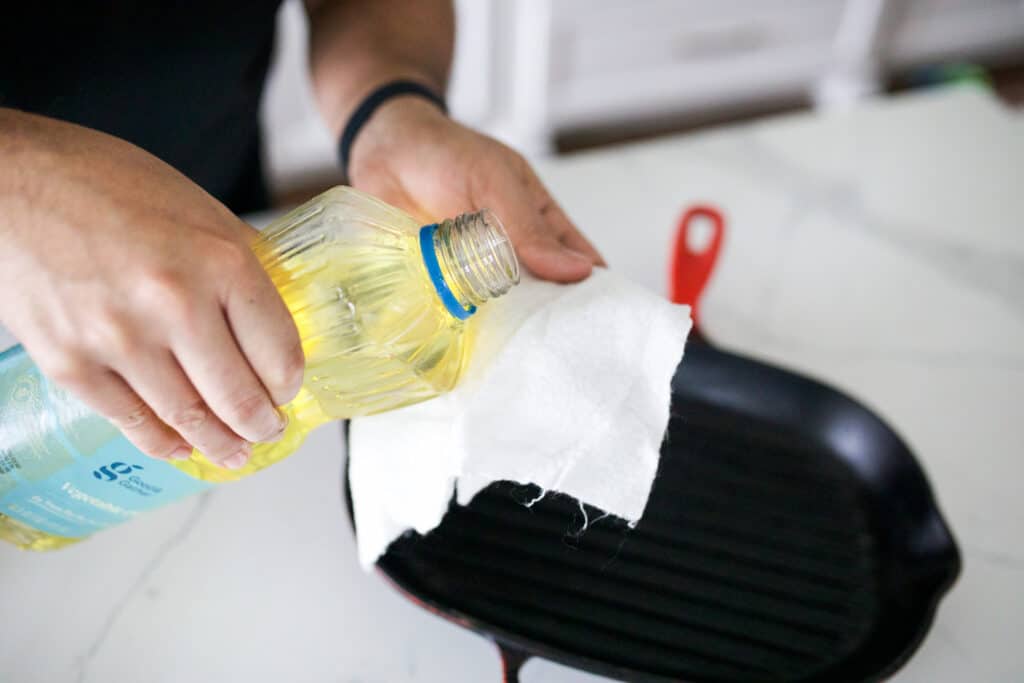
In this article, we’ll look at the four best oils for seasoning cast iron and which oil you should never use. I’ll also share some bonus tips on how to season cast iron to extend the piece’s longevity and keep it in excellent shape.
Table of Contents
Best Oils for Cast Iron Cooking and Seasoning
Not all oils are the same. Depending on the fruit or seed they derive from, they’ll have different chemical makeups which alter their smoke point.
This means that some oils are better suited for different heat applications. For example, Extra Virgin Olive Oil (EVOO) has a low-smoke point and is best for salad dressing. But avocado oil works for high-heat deep-frying. So whether you’re frying chicken, searing steak, or seasoning cast iron, there’s an ideal oil to fit the task perfectly.
Oils high in unsaturated fats are particularly well-suited for cast iron seasoning. It’s because their chemical makeup is optimized for polymerization.
Check out the four best-unsaturated oils for cast iron cooking and seasoning:
Refined Avocado Oil
Avocado oil is my absolute favorite oil to season cast iron with. Not only is it relatively affordable, but it has a neutral flavor and super high smoke point.
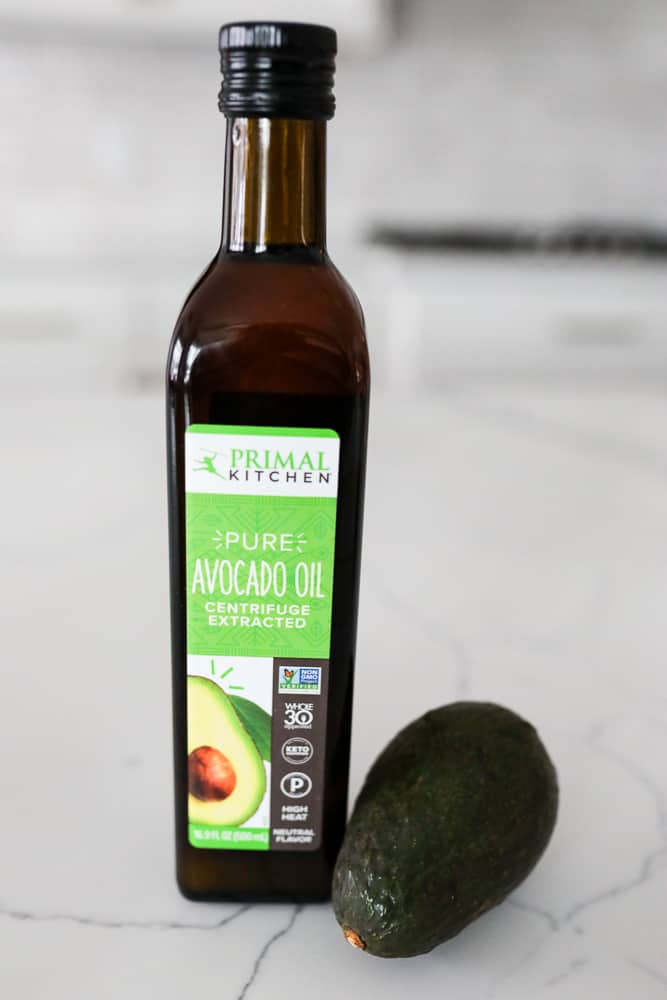
If possible, I suggest using refined avocado oil because it has a higher smoke point than unrefined. This means that once you’ve seasoned the cast iron, you won’t have to worry about the non-stick coating budging, no matter how you cook with it.
The best part is that you can use the remaining avocado oil for all your cooking. So you won’t end up stuck with an entire bottle of oil that only has one use in your kitchen.
If your oven can only reach 525°F, stick with unrefined avocado oil. But if your oven can reach 550°F, I recommend choosing refined avocado oil. You might have to crank your oven to “self-cleaning” mode, but if it works, it works!
Refined Canola Oil
Canola oil is another excellent choice for seasoning cast iron. It has a high smoke point at 425°F and is widely available and inexpensive compared to other oils.
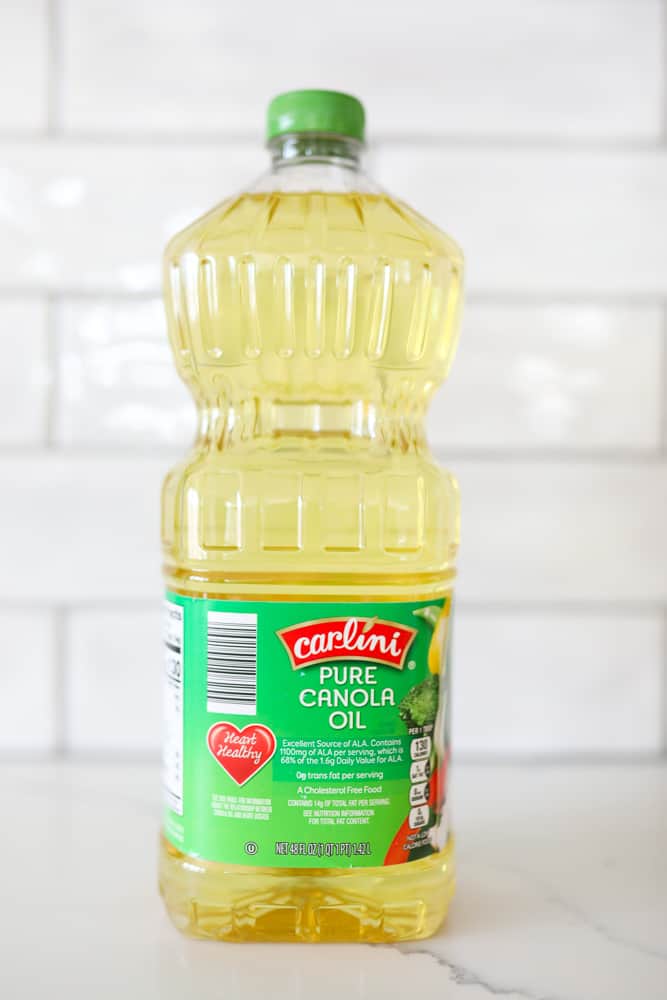
Plus, canola oil is high in monounsaturated fats, which can help create a strong and durable seasoning on the cast iron surface.
You can use the leftover canola oil for sauteing, stir-frying, grilling, baking, and marinades!
Grapeseed Oil
Grapeseed oil has a smoke point of 420°F and creates a durable non-stick coating on cast iron.
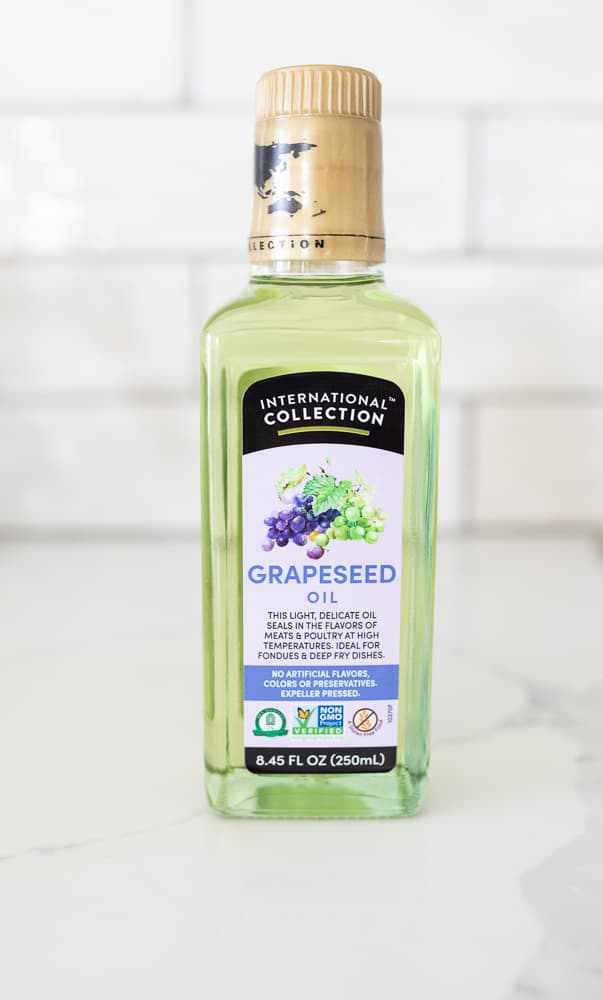
It’s easy to find at almost any grocery store and is the most affordable oil on this list. Even better, it’s just as versatile as avocado or canola oil.
Flaxseed Oil
Flaxseed oil is an outlier. Although it has the lowest smoke point at 225°F, it’s widely regarded as one of the best oils for seasoning cast iron. The kicker is that you must bake it at a lower temperature for multiple hours to create the seasoned coating.
It has tons of omega-3 fatty acids, which polymerize quickly to create the shiniest, smoothest, non-stick coating you’ll ever see.
Keep in mind that flaxseed oil can be costly at more than $1 per ounce. And because of its low smoke point, it’s not an oil you can cook with. Instead, it’s usually a finishing oil that you’d drizzle over a salad or prepared dish. But if you have a lot of cast iron to season, it might be worth it!
What Oil Should NOT Be Used on Cast Iron?
Stay away from butter or margarine when seasoning cast iron. These are the worst oils you could use, and more than likely, they won’t even create a seasoned coating.
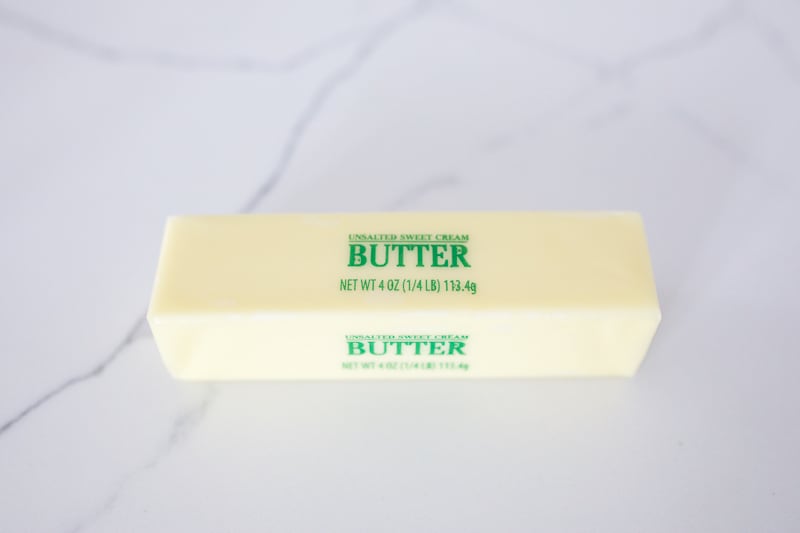
Butter is the worst because it has a low smoke point and a high percentage of milk solids. When introduced to high heat, the butter will burn and smoke. If a seasoned coating polymerizes at all, it’ll be sticky and flaky.
Margarine doesn’t have milk solids like butter, but it still has too low of a smoke point. If the oil doesn’t polymerize, it’ll burn, and the unsaturated fats in margarine will remain prone to oxidization. So over time, they’ll go rancid.
It might be tempting to use these readily available options. But you’re better off investing in avocado or grapeseed oil once to ensure the longevity of your cast iron cookware.
Bonus Tips: How to Season Cast Iron
The process of seasoning cast iron involves applying a layer of oil into the crevices and pores of the metal and heating it. As the oil reacts with the metal and heat, the fatty acids in the oil break down and reform into larger molecules that bond with the iron and each other.
The bonding creates a polymerized layer that shields the metal from rusting. Then, every time you cook with oil, the layer of seasoning thickens, resulting in a smooth, non-stick surface.
Here’s a step-by-step walkthrough for seasoning cast iron for the first time:
1. Preheat
Preheat your oven to at least 25°F above the smoke point of the oil you’ve chosen to use.

2. Wash
Meanwhile, thoroughly wash your cast iron with warm water and mild dish soap.
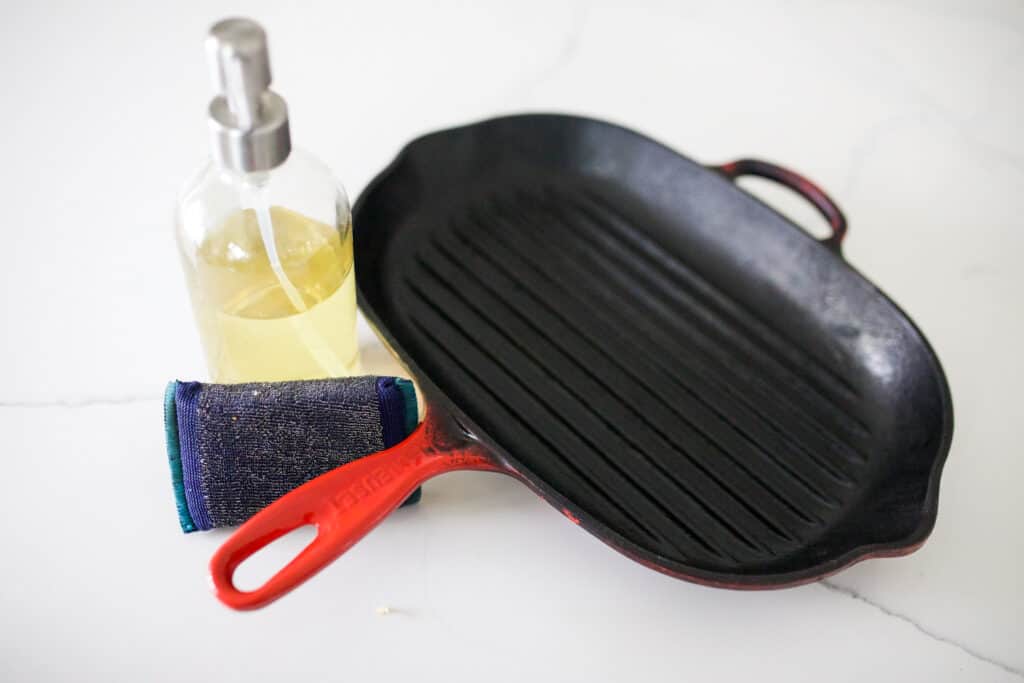
3. Dry
Dry the cast iron completely.
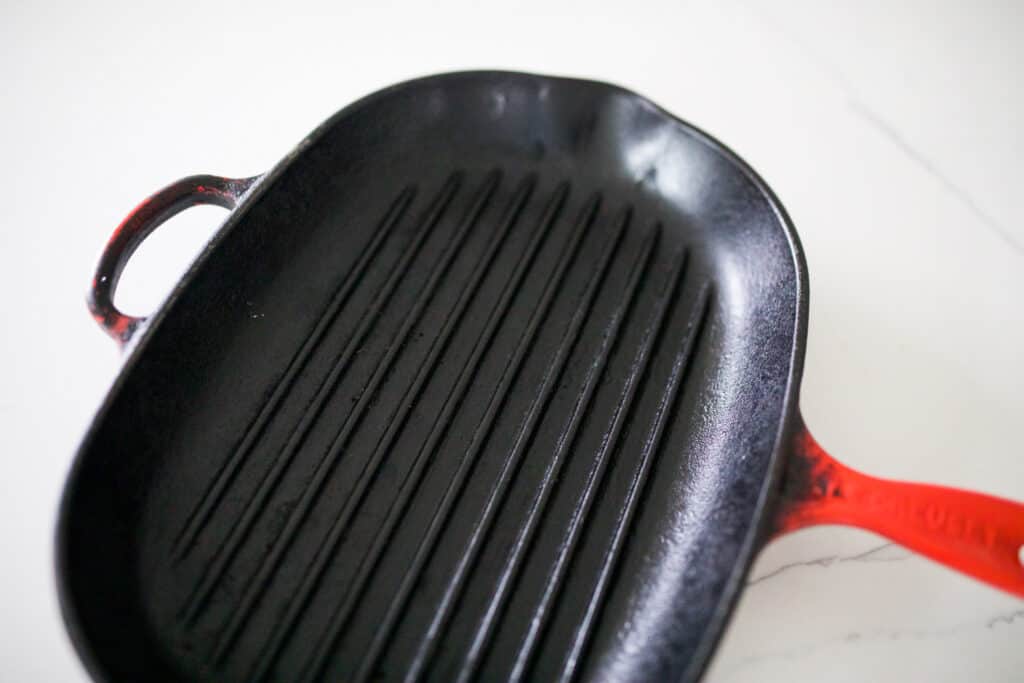
4. Oil
Apply a layer of oil to the entire surface of the cast iron—the inside, outside, handle, everything.

5. Buff
With a dry paper towel or cloth, buff away any excess oil.
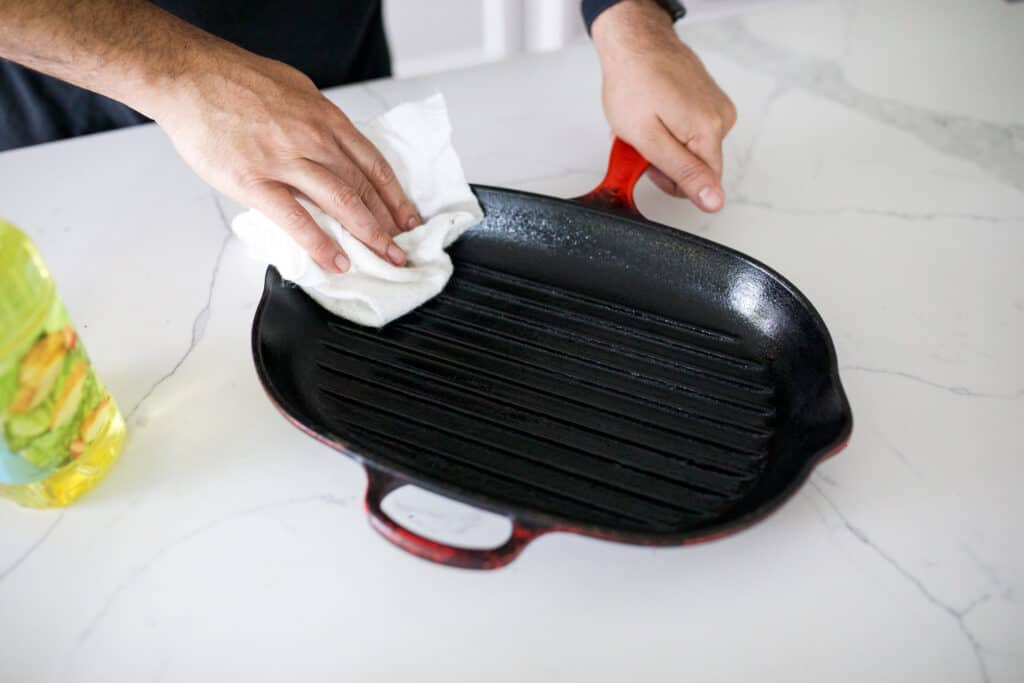
6. Bake
Transfer the cast iron to the preheated oven for one hour. Bake upside down to prevent any oil pooling. You can place a baking sheet on a lower rack to catch any excess oil.
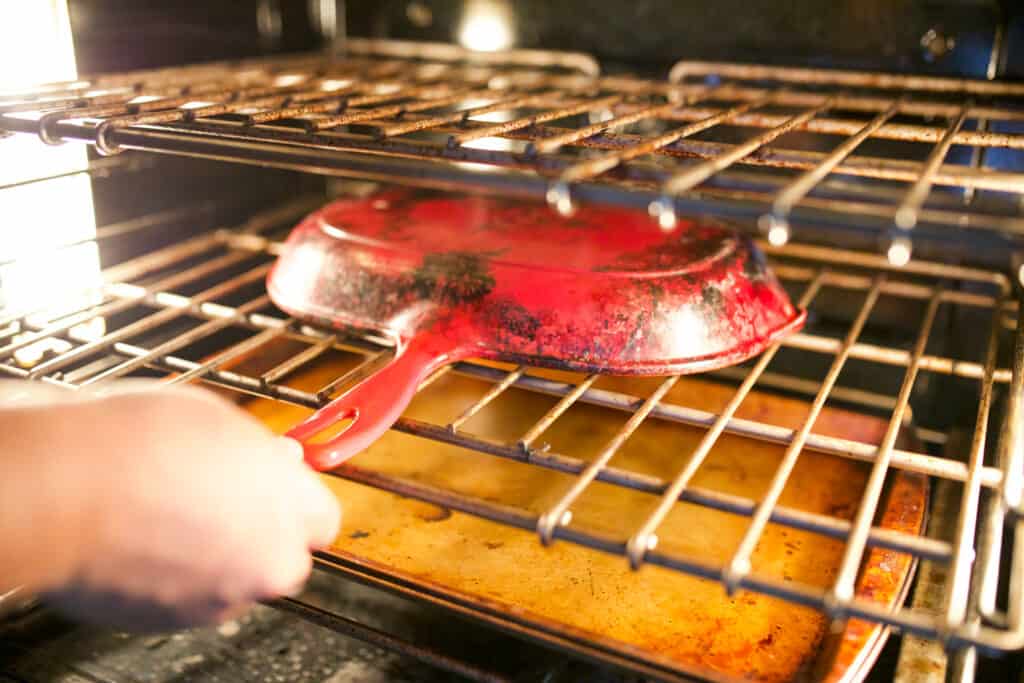
7. Cool
Turn off the oven and leave the pan inside to gradually cool for at least 15 minutes.
You can repeat this process as many times as you’d like until you’re happy with the smooth, shiny, non-stick surface.
If your cast iron comes out of the oven still a little tacky or sticky, we’ve compiled a list of troubleshooting tips to fix it.
If you plan on using cast iron on a glass cook top, we have some tips and tricks for you here.
The Bottom Line
Cast iron cookware needs regular seasoning, and the type of oil used makes all the difference.
Some oils are better suited for different heat applications. For example, oils high in unsaturated fats are particularly well-suited for cast iron seasoning. It’s because their chemical makeup is optimized for polymerization.
The four best oils for seasoning cast iron are refined avocado oil, canola oil, grapeseed oil, and flaxseed oil, but each has pros and cons.
My best overall pick is avocado oil. Not only is it easy to get a hold of, but it also has the highest smoke point of all the oils listed. Not to mention its versatility means you won’t have to waste any leftover oil.
If you have a bunch of cast iron to season, you might want to splurge on flaxseed oil. Of course, it’ll take more time to season, but the durable results are worth the effort.
Seasoning Cast Iron FAQs
Olive oil doesn’t have a high enough smoke point to be suitable for seasoning. So instead, you should use high-heat alternatives like avocado, canola, or grapeseed oil.
Yes, you can over-oil cast iron. When seasoning cast iron, it’s essential that you buff away any excess oil with a dry paper towel before baking it. Applying too much oil can cause the seasoning to become sticky, gummy, or flaky, and it can make the pan more prone to burning and smoking during cooking.
Yes, it is bad to leave oil on cast iron. Any oil that remains on cast iron that has not been polymerized can go rancid. If that happens, you’ll have to remove all the hard-won non-stick layers to start seasoning from scratch. It’s best practice to thoroughly wipe down or clean your seasoned cast iron with warm water and mild dish detergent.

